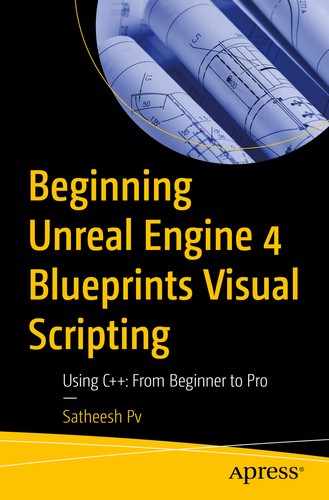In this final chapter, you create a demo game using the default First Person Shooter Template (Blueprint version) that comes with Unreal Engine (Launcher version) and extend it to include various features, such as ammo count, ammo pickup, and so forth. After the features are done, you learn how to package the game for Windows.
Creating the Project

.Unreal Project Browser
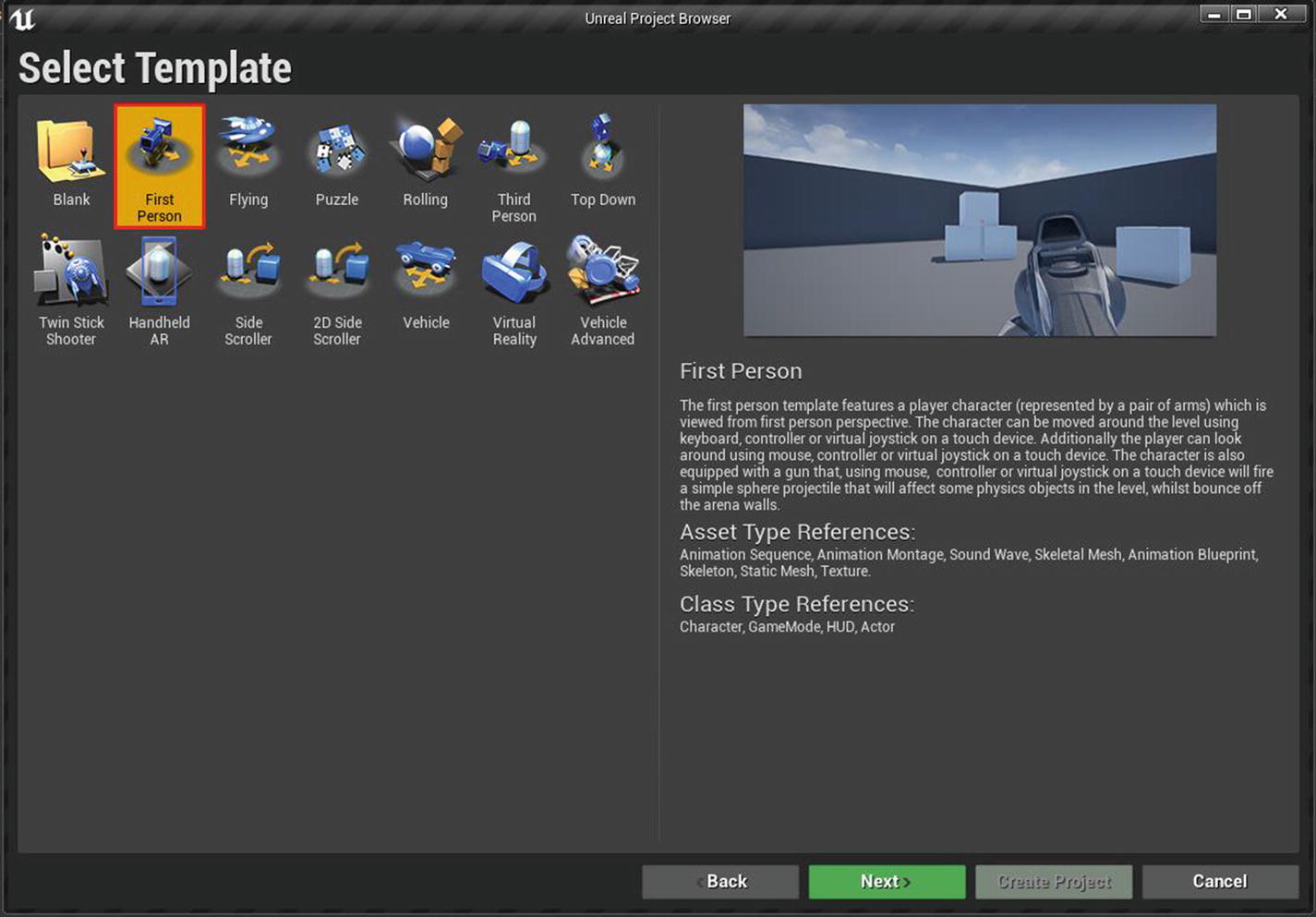
Select First Person Template

Choose C++ project type
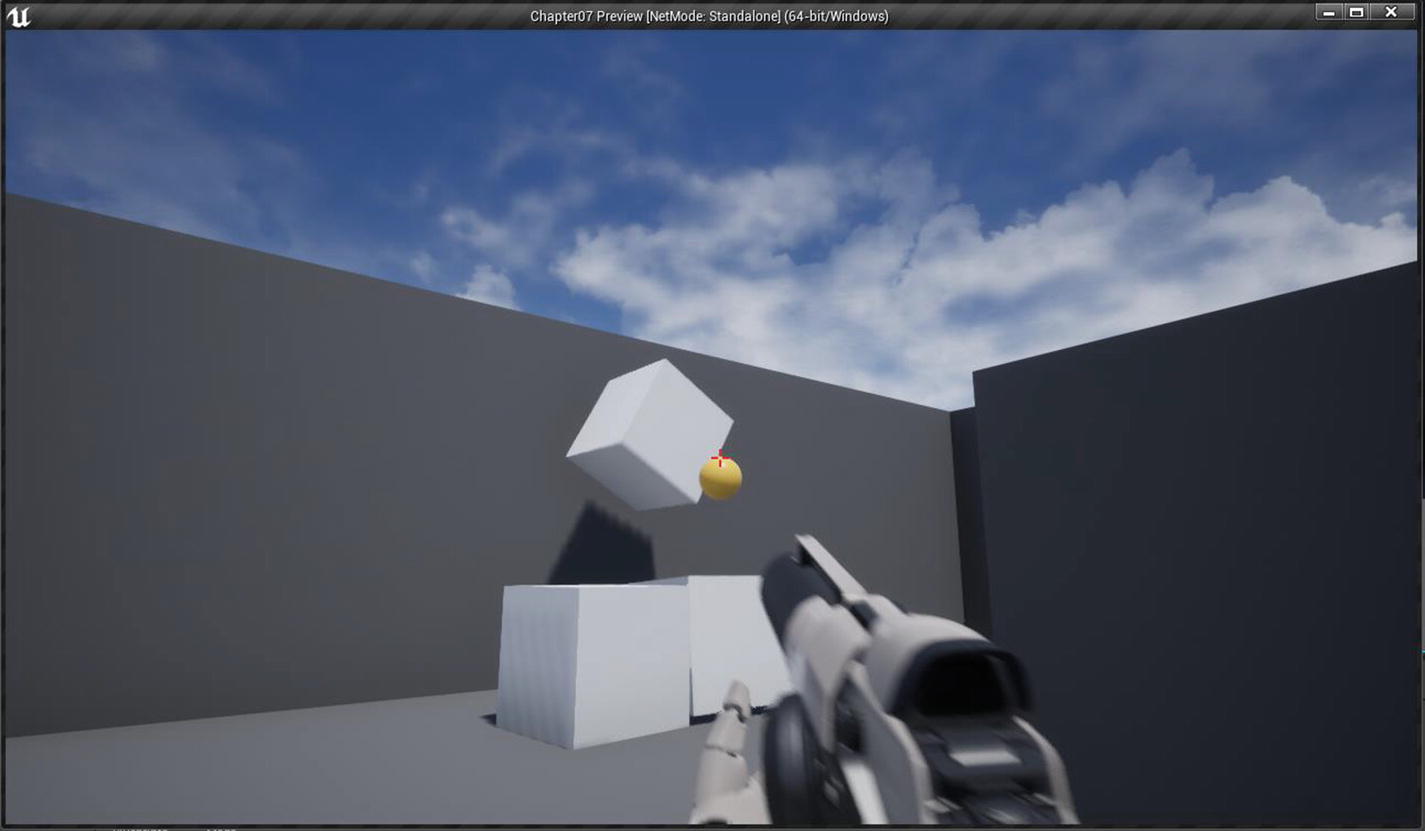
Physics enabled boxes
Ammo Setup
As you may have noticed, you can shoot the projectiles as much as you want. We need to change this. We need settings for the number of clips the weapon can have and the amount of ammo per clip. For example, if this weapon has 3 clips and 20 rounds of ammo per clip, then the maximum amount of ammo this weapon can have is 3 * 20 = 60. Every time you shoot 20 rounds of ammo, each clip is depleted. There is a two-second timeout before shooting the next clip. In a real project, this timeout is replaced by a reload animation. We will use variables to define the values so you can adjust everything without having to worry about the inner workings.
Max Clips (integer): The maximum number of clips the weapon can have. Default 5.
Starting Clips (integer): The number of clips the weapon has when the game starts. This should never be greater than Max Clips. Default 3.
Ammo Per Clip (integer): The amount of ammo per clip. Default 20.
Current Clips (integer): The number of clips the weapon currently has. Every time the weapon reloads, subtract this variable by one to denote that the clip has been used. Default 0.
Current Ammo (integer): The amount of ammo the weapon currently has. Every time you shoot, subtract this variable by one to denote that you fired one bullet. Default 0.
bCanShoot (boolean): True or false variable that determines if you can shoot or not. Default false.
ReloadTime: Time in seconds for the weapon to reload when all bullets have fired. Default 2.
Press F5 to compile and start the project from Visual Studio. After the Editor has started, open FirstPersonCharacter Blueprint and the Construction Script graph.
Drag a wire from Construction Script’s output pin, search for Sequence node, and add it. The Sequence node is a special Blueprint node that allows you to run multiple outputs (you can add as many outputs as you want) from top to bottom. Add a Branch node and connect the first output of the Sequence node (with the label Then 0) to the Branch node.
You need to use the Branch node condition to ensure that Starting Clips is not greater than Max Clips. Drag and drop both Starting Clips and Max Clips from the My Blueprints tab to the Construction Script graph. Drag a pin from Starting Clips, search for the > symbol, and select integer > integer node (Starting Clips is now automatically connected to the first input of the > node). This node returns true if the first input is greater than the second input, so connect Max Clips to the second input of > (greater than) node and connect the red output to the Condition input of the Branch node.
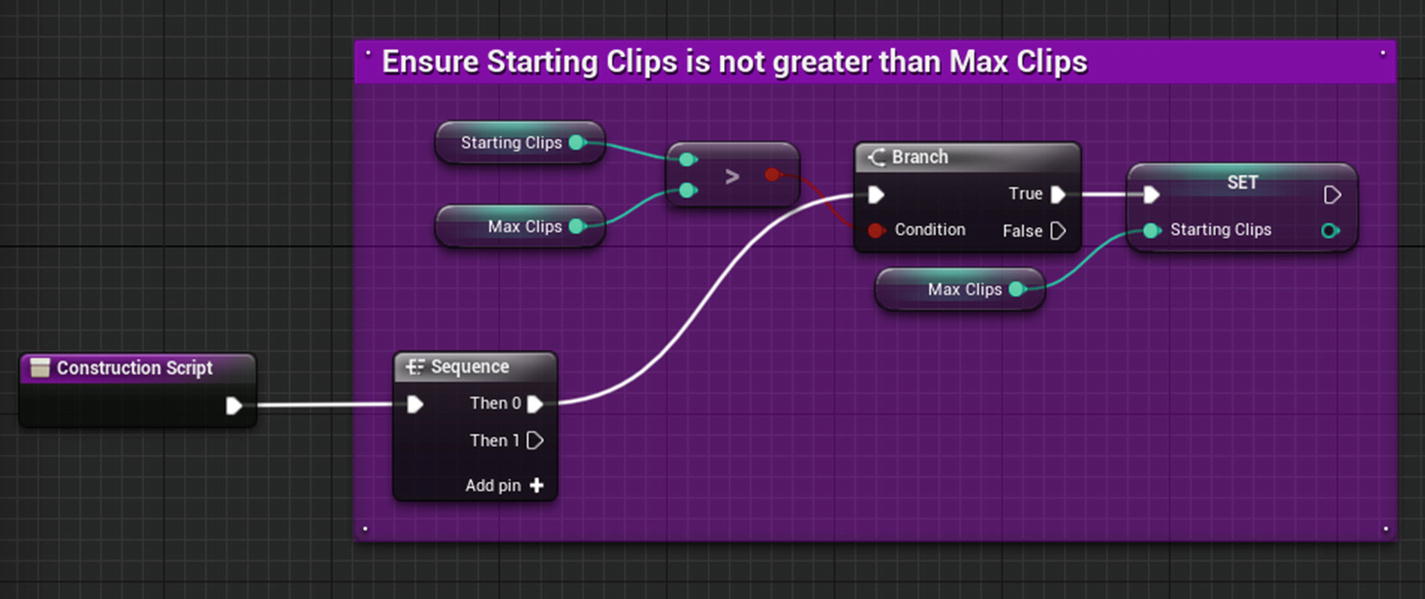
Ammo setup. Setting starting clips
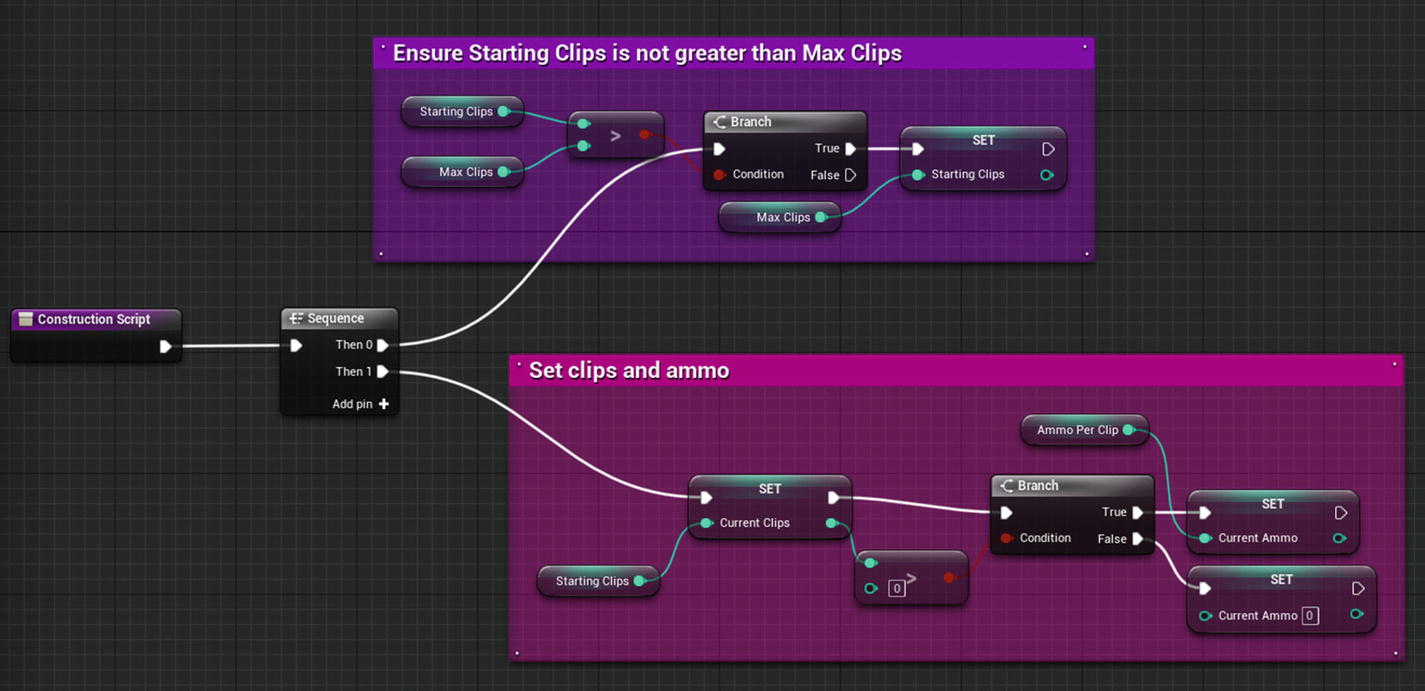
Ammo setup. Setting current ammo
- 1.
Set node for the Can Shoot boolean variable.
- 2.
Get the node for Current Ammo.
- 3.
Greater than integer node (Integer > integer).

Setting if we can shoot
You have now defined a basic logic for ammo and clips, so it’s time to make use of them.

Add C++ event in Blueprint
Select it and right-click again in the graph, search for Get Current Ammo and select it. Drag a wire from the Current Ammo and search for Decrement Int and select it. This macro node takes an integer, subtracts it by 1, sets the value, and returns it, so the output pin contains the result of Current Ammo – 1.
If the output node of Decrement Int is not 0, don’t do anything because the player can fire again. If it is 0, it means you ran out of ammo. To compare the results, right-click the graph, search for Compare Int, and add it. Then connect the Decrement Int node’s output to the first input (with label Input) of Compare Int.
This is also a macro that has three output nodes and two input nodes. The first input node is the value to compare, and the second input is the value to compare with. If the first input value is greater than the second input, the first output triggers. If the first input is the same as the second input, then the second output is triggered. If the first input is less than the second input, the third output is triggered.

Updating Current Ammo and Can Shoot variables

Adding event to Timer

Rename event to reload
- 1.
Check if you have any clips left. If you have a clip, then decrement it by one and set Current Ammo to Ammo per clip.
- 2.
Enable or disable the Can Shoot variable based on Current Ammo (see Figure 7-12).

Updating Can Shoot variable
With the reload event done, you have finished our ammo setup. If you go back to viewport, press play, and start firing, you eventually run out of ammo, and it automatically reloads after 2 seconds. Once you run completely out of clips, you won’t be able to shoot the gun anymore.
From here, you move forward to implement a HUD and a pickup item. First, you create a basic HUD using Unreal Motion Graphics (UMG), which displays the amount of ammo you have. Then you move on to create an ammo pickup item that replenishes ammo.

Adding Text Block in UMG Designer

Setting Ammo Text as variable
It is important to set Is Variable to true; otherwise, you can’t access it in the Event Graph. You can also expand the Anchors section and set Minimum and Maximum to 1. Now you can switch to the Graph tab (top-right corner) and create a new custom event by right-clicking inside the graph and selecting Add Custom Event… under the Add Event category. You call this new event UpdateAmmo and add two integer parameters. The first input is called CurrentAmmo, and the second input is called TotalAmmo. Since you enable Is Variable for AmmoText in the Designer tab, you can now drag and drop a reference to our text block from the My Blueprint tab. Drag a wire from the Ammo Text node and search for set text and select it. This node takes a Text input, so you create a formatted text using a special node. Right-click inside the graph, search for Format Text, and select that node. This node helps to build formatted text using curly braces {}.
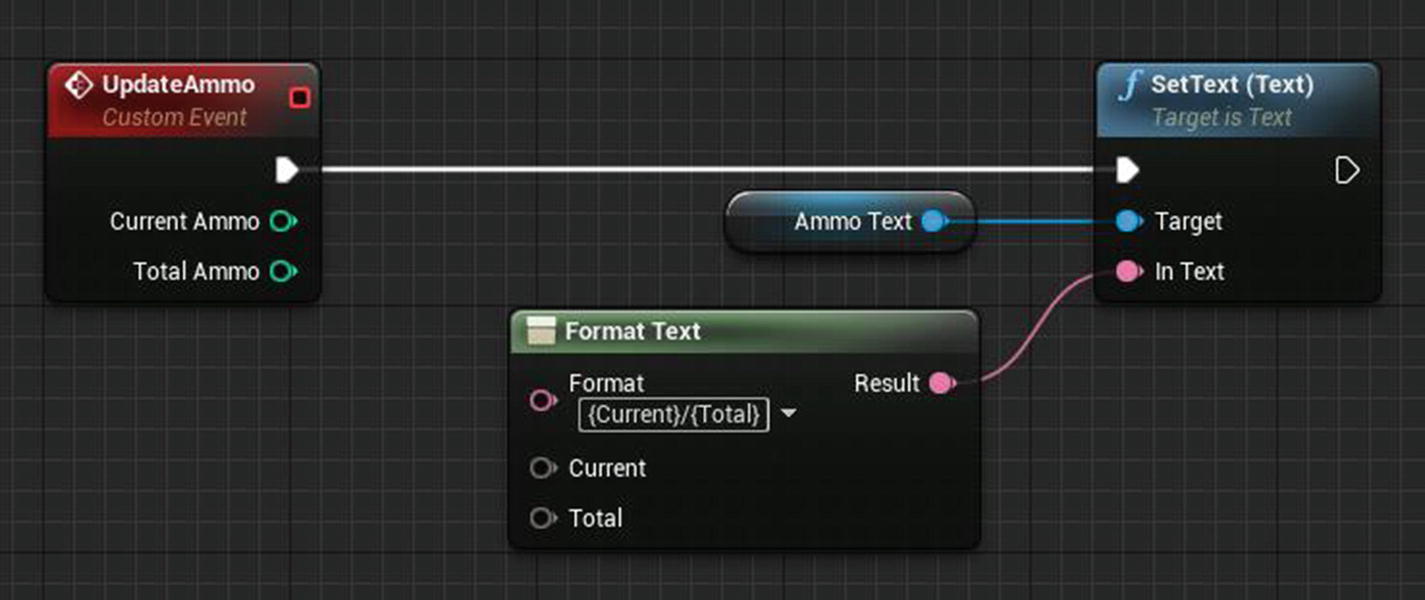
Setting Text using Format Text node
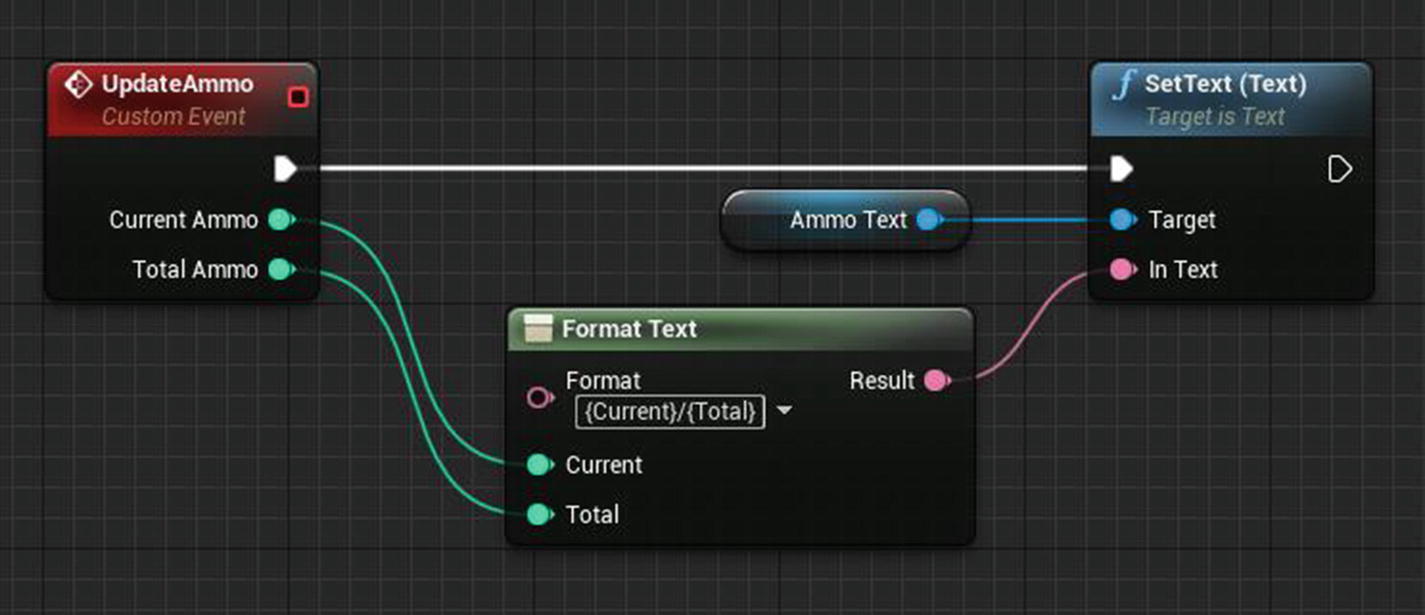
After connecting to Format Text
Now all that is left is to call this event from our First Person Character Blueprint class. To do that, you first need to create this HUD in that class. Open the FirstPersonCharacter Blueprint class and find the Event BeginPlay node. This node is automatically called when the game starts for this actor.

Add Player HUD to viewport

Game screen with Player HUD added
Since you have to update the ammo whenever the game starts, you need to call the Update Ammo event in multiple places when you shoot and after reload. It’s better to create a function, so from the My Blueprint tab, create a new function and name it UpdateAmmo. Open this function graph, and drag and drop the PlayerHUD (select Get PlayerHUD in the context menu) variable into this graph. Drag a wire from the PlayerHUD variable and search for Update Ammo and select it. You made two inputs for that, so for the first input, connect the Current Ammo variable. For the second input, you need the total ammo.

Updating Ammo in Player HUD

Calling Update Ammo function after Begin Play

Calling Update Ammo after firing weapon

Calling Update Ammo after Reloading
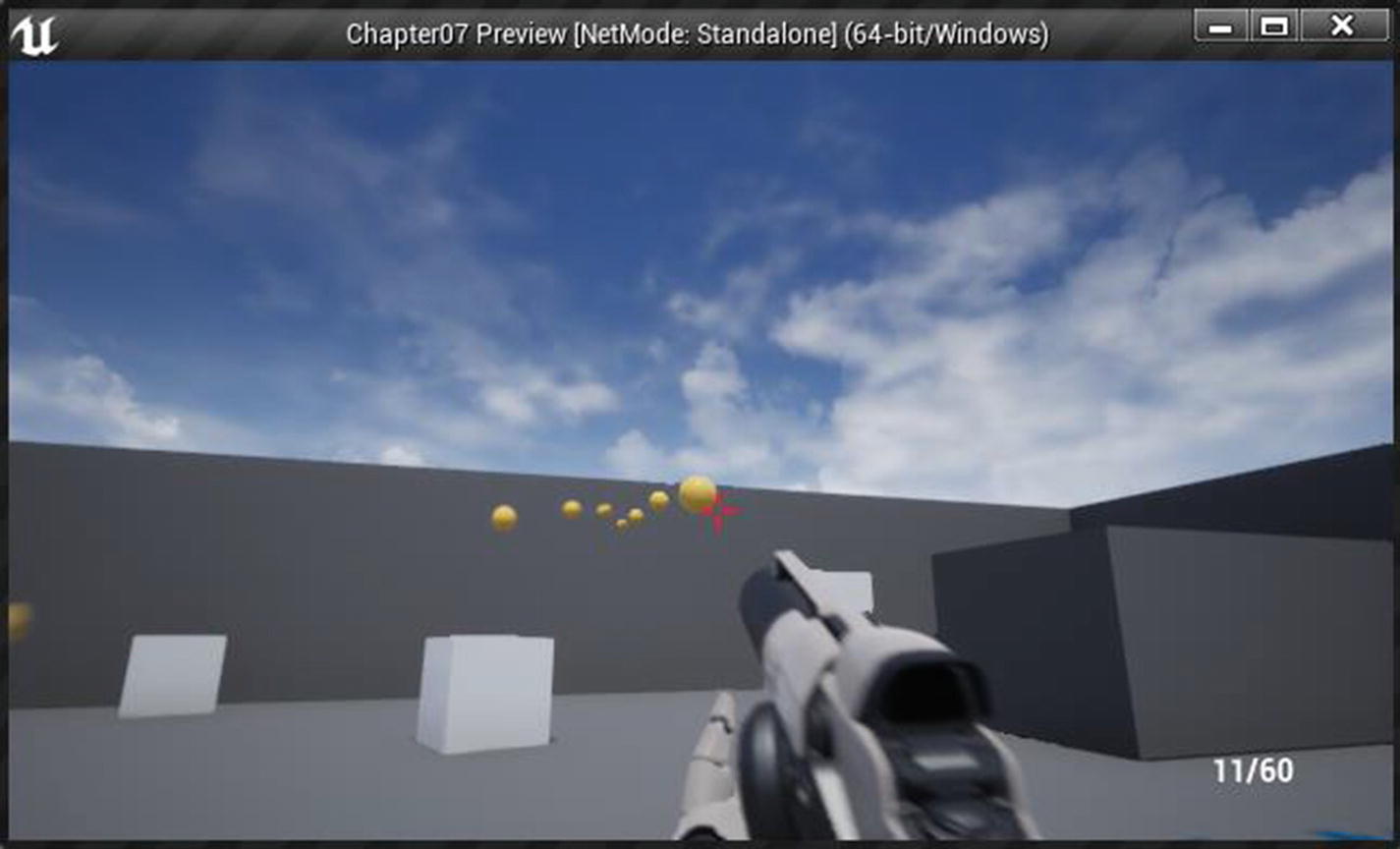
Ammo count updating on Player HUD
Ammo Pickup
- 1.
Instead of using MyItemTrace for the name, use ItemPickup.
- 2.
Set the start location of the trace to the world location of Sphere Component. Add this location to the multiply node and then connect the result to the Line Trace node’s End input (see Figure 7-24).

Updating end location of Line Trace
Right-click the graph, search for Input Action Trace, and select the Trace node. Connect the Trace node Pressed execution pin to the Line Trace By Channel node. You have the tracing setup done, for now, so let’s create our Replenish ammo function, which grants us a single clip.
Create a new function and call it ReplenishAmmo. This function has no inputs, but you create a boolean output, which determines if the ammo was successfully replenished. To create an output, select the function (either in My Blueprint tab or open function graph and select the purple node), and in the Details panel, click the plus button under the Outputs category. This creates a new Return node with a boolean output.
Rename the NewParam output to bReturnValue. This function is responsible for adding a new clip under Max Clips. First, drag and drop the Current Clips variable into the graph (select Get CurrentClips in the context menu). Drag a wire from this variable, search for less, and select integer < integer node. CurrentClips is now automatically connected to the first input of < node. Let’s drag and drop the MaxClips variable into the graph (select Get MaxClips in the context menu) and connect it to the second input of < node.

Replenish Ammo
Go to Content Browser, create a new Blueprint class (Actor based), and call it BP_AmmoPickup. This is our class that grants the player a single ammo clip and destroys itself. Open our newly created actor (BP_AmmoPickup) and create a new custom event. Let’s call it GiveAmmo and add a new input to this event, set the type to FirstPersonCharacter, and name it Character.

Give Ammo event
Even though you have done our functions and events, you aren’t using any of it yet, so let’s fix that. Let’s go back to the tracing setup. Create a new Branch node and connect the Return Value of Line Trace node to the Condition input of the Branch node. You only want to continue if the trace hits something.
Drag a wire from the Out Hit node and select Break Hit Result. Expand the Hit Result node by clicking the arrow button and drag a wire from the Hit actor pin. Search for Cast to BP_AmmoPickup node and select it. This is a handy node that tries to convert the given Object input to the respective type and triggers the first output if successful or Cast Failed if the conversion has failed.

Giving ammo from line trace result
And you are done! Drag and drop the BP_AmmoPickup class into the game world and press Play (Alt+P). Keep shooting until you run out of ammo. And then go near an ammo pickup item in the world and press E to trace and pick up the item.
Package Game
The packaging game is a straightforward process. Packaging is the process of compiling and cooking the content in an optimized way for the target platform it is meant to run. When the packaging command is invoked, all the source code (if any) is compiled first. If the compilation is successful, then all the contents (Blueprints, Meshes, Textures, Materials, and so on) are converted (also known as cooking) into a special format that can be used by the target platform. Unreal Engine supports a wide variety of platforms, and from a Windows machine, you can compile and package for any platform except Apple Mac.

Accessing project settings
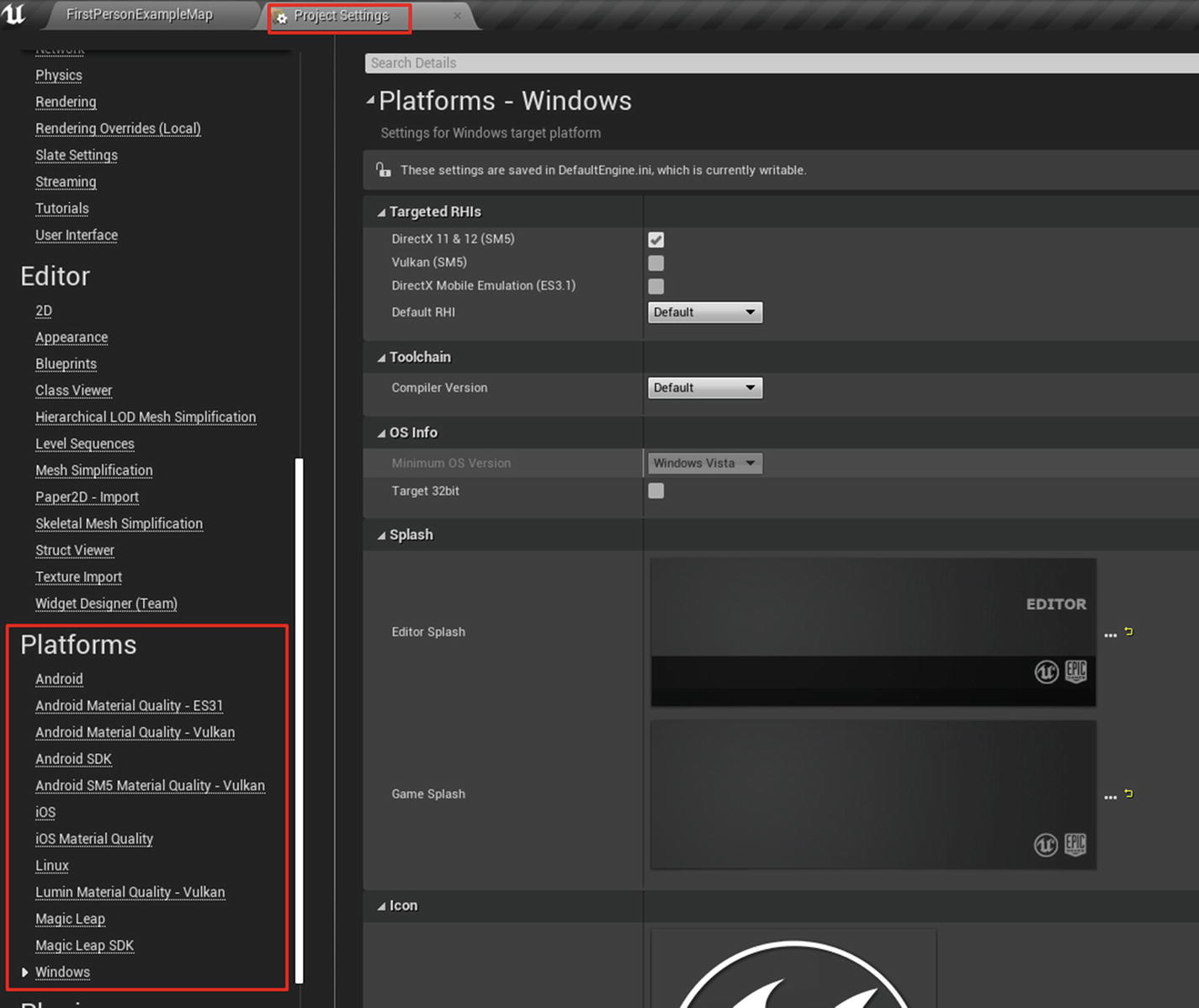
Platform category

Accessing packaging settings
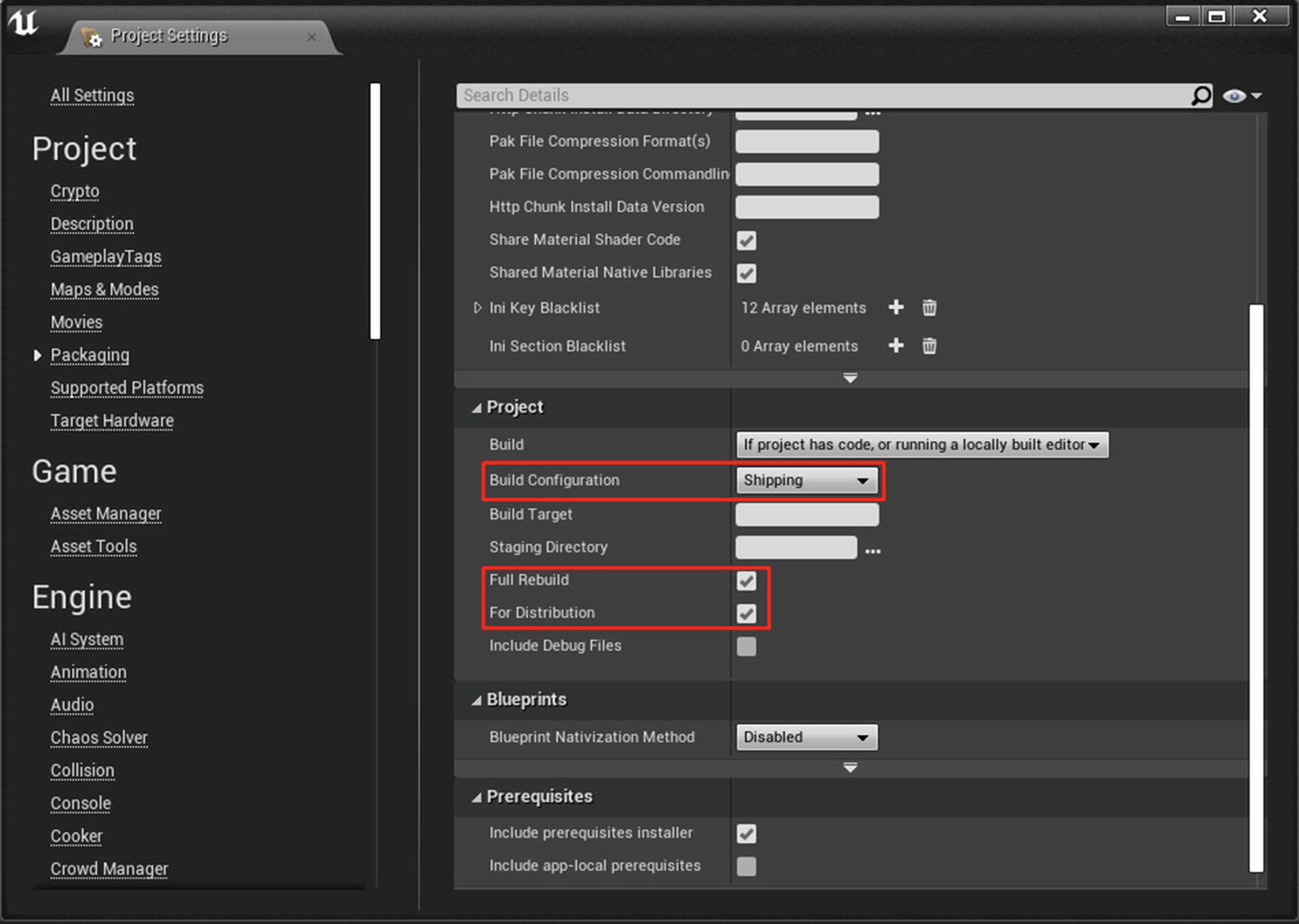
Selecting Shipping configuration

Toast notification showing packaging for Windows
You can click the Show Output Log on the Toast notification to see the build process.
